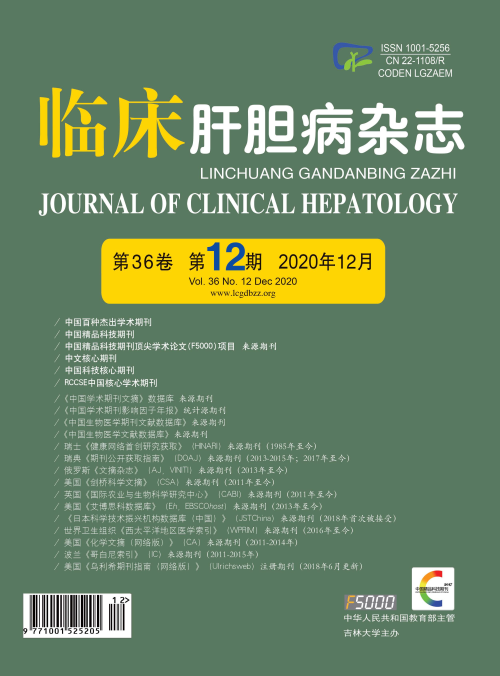|
[1] RENNER IG,SAVAGE WT 3rd,PANTOJA JL,et al. Death due to acute pancreatitis. A retrospective analysis of 405 autopsy cases[J]. Dig Dis Sci,1985,30(10):1005-1018.
|
|
[2] STEER ML. Relationship between pancreatitis and lung diseases[J]. Respir Physiol,2001,128(1):13-16.
|
|
[3] WANG D,LI Y,FAN LQ,et al. Expression and significance of NF-kB,IL-6 and TNF-αin liver injury interfered by thoracic duct drainage of severe acute pancreatitis[J]. J Hebei Med Univ,2010,31(8):905-908.(in Chinese)王冬,李勇,范立侨,等.大鼠重症急性胰腺炎肝损伤经胸导管引流干预时NF-κB、IL-6、TNF-α的表达及意义[J].河北医科大学学报,2010,31(8):905-908.
|
|
[4] WANG HM,ZHANG SW. Research progress of magnolol pharmacology[J]. Beijing J Tradit Chin Med,2009,28(7):562-565.(in Chinese)王海曼,张淑文.厚朴酚药理作用的研究进展[J].北京中医药,2009,28(7):562-565.
|
|
[5] MIAO B,ZHANG SW,WANG H,et al. Magnolol pretreatment prevents sepsis-induced intestinal dysmotility by maintaining functional interstitial cells of Cajal[J]. J Capit Med Univ,2013,34(2):163-170.(in Chinese)苗彬,张淑文,王红,等.Cajal细胞在脓毒症所致胃肠动力障碍中的形态改变及厚朴酚干预的实验研究[J].首都医科大学学报,2013,34(2):163-170.
|
|
[6] ZHANG YL,YUAN WH,XU M,et al. The role of cold-inducible RNA-Binding protein(CIRP)in early liver damage of severe acute pancreatitis with secondary infection[J]. Chin J Dig,2011,31(5):330-334.(in Chinese).张尤历,袁伟红,徐岷,等.重症急性胰腺炎继发感染早期肝损伤时髓样细胞表达激发受体-1的诊断价值[J].中华消化杂志,2011,31(5):330-334.
|
|
[7] FENG SY. Rhubarb to prevent gastrointestinal failure[J]. Chin J Integr Trad West Med,2000,20(10):795-797.(in Chinese)冯顺友.大黄防治胃肠功能衰竭[J].中国中西医结合杂志,2000,20(10):795-797.
|
|
[8] YE ML,PENG Y. Research advance in the mechanism of intestinal motility disorders in patients with severe acute pancreatitis[J]. Med Recapitul,2016,22(20):4039-4042.(in Chinese).叶美玲,彭燕.急性重症胰腺炎肠道动力障碍机制的研究进展[J].医学综述,2016,22(20):4039-4042.
|
|
[9] ZHANG Y,TANG F. Advance in latest studies on pharmacological effects of magnolol[J]. China J Chin Mater Med,2012,37(23):3526-3530.(in Chinese)张勇,唐方.厚朴酚药理作用的最新研究进展[J].中国中药杂志,2012,37(23):3526-3530.
|
|
[10] QIN C,DAI X,YANG XQ,et al. Intervention effect of honokiol on inflammatory response in lung tissue of asthma mice and its mechanism[J]. J Jilin Univ(Med Edit),2020,46(2):214-220,431.(in Chinese)秦超,戴曦,杨小琼,等.和厚朴酚对哮喘小鼠肺组织炎症反应的干预作用及其机制[J].吉林大学学报(医学版),2020,46(2):214-220,431.
|
|
[11] DUAN JQ,LIN Y,ZHAO QF,et al. The protective effect and mechanism of magnolol on acute lung injury in sepsis rat model[J]. Chin J Gerontol,2018,38(11):2745-2747.(in Chinese)段金旗,林艳,赵芹芳,等.厚朴酚对脓毒症大鼠模型急性肺损伤的保护作用及机制[J].中国老年学杂志,2018,38(11):2745-2747.
|
|
[12] SEELY AJ,NAUD JF,CAMPISI G,et al. Alteration of chemoattractant receptor expression regulates human neutrophil chemotaxis in vivo[J]. Ann Surg,2002,235(4):550-559.
|
|
[13] PASZKOWSKI AS,RAU B,MAYER JM,et al. Therapeutic application of caspase 1/interleukin-1beta-converting enzyme inhibitor decreases the death rate in severe acute experimental pancreatitis[J]. Ann Surg,2002,235(1):68-76.
|
|
[14] LIU ZY,FEI H,LIU J,et al. The role of daphnetin pretreatment on histopathologic changes and serum IL-6,IL-10 levels in a-cute pancreatitis rats[J]. Chin J Microcirc,2016,26(2):1-4,85.(in Chinese)刘志勇,费浩,刘娇,等.瑞香素预处理对急性胰腺炎大鼠组织病理变化和白细胞介素-6、白细胞介素-10水平的作用[J].微循环学杂志,2016,26(2):1-4,85.
|
|
[15] SONG RB,MA JT. Regulation of IL-10 on inflammation-related cytokines in severe pancreatitis in rats[J]. Hebei Med J,2009,31(12):1451-1452.(in Chinese)宋润波,马建亭.IL-10对大鼠重症胰腺炎炎症相关细胞因子的调节作用[J].河北医药,2009,31(12):1451-1452.
|
|
[16] LI L,YU J,MU R,et al. Clinical effect of electroacupuncture on lung injury patients caused by severe acute pancreatitis[J]. Evid Based Complement Alternat Med,2017,2017:3162851.
|
|
[17] ZHANG G,LIU XB,HU WM. Relationship between TNFαgene expression and lung injury in the lungs of acute pancreatitis rats[J]. World Chin J Dig,2000,8(2):142.(in Chinese).张刚,刘续宝,胡伟明.急性胰腺炎大鼠肺内TNFα基因表达与肺损伤的关系[J].世界华人消化杂志,2000,8(2):142.
|
|
[18] LU HH,SHI Z,LIU B,et al. Effects of TNFα,IL-1,IL-6 in acute pancreatitis-associated acute lung injury[J].Chongqing Med,2007,36(18):1818-1819.(in Chinese)陆海华,史忠,刘波,等.急性胰腺炎相关性肺损伤患者早期血清TNFα、IL-1、IL-6的变化及其临床意义[J].重庆医学,2007,36(18):1818-1819.
|
|
[19] WANG M,WANG B. HMGB1 of sepsis biomarkers and drug target of traditional Chinese medicine[J]. Jilin J Tradit Chin Med,2018,38(4):494-496.(in Chinese)王淼,王兵.HMGB1作为脓毒症生物标记物与中药药物靶点的研究进展[J].吉林中医药,2018,38(4):494-496.
|
|
[20] WANG J,HUANG Z,WEI W,et al. The expression of HMGB1 in lung injury and the effect of ulinastatin on rats with severe acute pancreatitis[J]. Med J West China,2018,30(2):174-177,181.(in Chinese).王静,黄忠,魏尉,等.HMGB1在重症急性胰腺炎大鼠肺损伤中的表达及乌司他丁的干预效应[J].西部医学,2018,30(2):174-177,181.
|
|
[21] SIMS GP,ROWE DC,RIETDIJK ST,et al. HMGB1 and RAGE in inflammation and cancer[J]. Annu Rev Immunol,2010,28:367-388.
|














 DownLoad:
DownLoad: